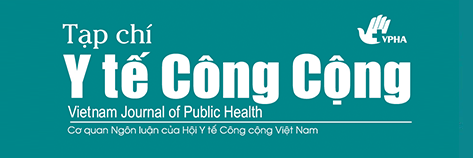Nghiên cứu can thiệp nhằm làm giảm ô nhiễm phân (E.coli) trong nước uống tại hộ gia đình ở khu vực miền núi, tỉnh Lào Cai, Việt Nam (An intervention study to reduce the faecal (E. coli) contamination of household drinking water in a mountainous area, Lao Cai province, Vietnam)
Tóm tắt
Chúng tôi tiến hành chọn 100 hộ gia đình tại hai xã miền núi trong đó có 50 hộ đã tham gia nghiên cứu cơ bản về chất lượng nước năm 2009 và được xem là nhóm chứng. Năm 2010, 50 hộ này được nhận viên khử khuẩn nước AQUATAB và bình trữ nước an toàn 20L (nhóm can thiệp 1). Năm mươi hộ còn lại được lựa chọn ngẫu nhiên và được nhận bình trữ nước an toàn 20L dùng để trữ nước uống sau khi đun sôi (nhóm can thiệp 2). Chúng tôi lấy mẫu nước tại mỗi hộ gia đình 2 tuần/lần, trong vòng 4 tháng của năm 2009 (đối với nhóm chứng) và 2010 (nhóm can thiệp 1 và 2). Mức độ ô nhiễm E.coli trong nước uống của hộ gia đình từ nhóm can thiệp 1 (GTTB: 1,17 E.coli/100mL, 95% CI: 10,99-17,7) thấp hơn đáng kể so với những mẫu nước được thu thập từ nhóm can thiệp 2 (13,95: 95% CI: 10,99-17,70) và nhóm chứng (11,38: 95% CI:9,32-13,88) (P <0,001). Trong khi 92% mẫu nước từ các hộ gia đình của nhóm can thiệp 1 đã đáp ứng được tiêu chuẩn của WHO về nồng độ E.coli trong nước uống (0 vi khuẩn/100 ml), chỉ có 41,5% và 32,8% mẫu nước uống trong các hộ gia đình ở nhóm can thiệp 2 và nhóm chứng đạt được tiêu chuẩn này.
English abstract
A total of 100 households were selected in a longitudinal study conducted in two mountainous communes in 2009-2010. Fifty households where drinking water boiling practice was common had been chosen in the baseline study in 2009 as a control group and in 2010 these 50 households were re-selected and provided water purification tablets together with 20 liter plastic narrow-necked containers (intervention 1 group). We selected another 50 households which stored drinking water after boiling in 20 L plastic narrow-necked containers (intervention 2 group). Treated drinking water samples were collected biweekly during four months of intervention in 2009 (control) and 2010 (intervention 1 and 2). E.coli contamination level of household drinking water from the intervention 1 group (geometric mean: 1.17 E.coli/100mL, 95% CI: 10.99-17.7) was significantly lower than those from the intervention 2 (13.95, 95% CI: 10.99-17.70) and the control group (11.38, 95% CI: 9.32-13.88) (P<0.001). While 92% of samples from households of the intervention 1 group met WHO guidelines for 0 E.coli/100 ml, only 41.5% and 32.8% samples in the intervention 2 and control households met such a benchmark.
Từ khóa
Toàn văn:
PDF (English)##submission.citations##
Wright, J., S. Gundry, et al. (2004). Household drinking water in developing countries: a systematic review of microbiological contamination between source and point-of-use.Trop Med Int Health 9(1): 106-117
Anh, V. T., Mølbak, K., Cam, P. D., & Dalsgaard, A, (2010), "Factors Associated with Faecal Contamination of Household Drinking Water in a Rural Area, Vietnam," in Sustainability in Food and Water, 18 edn, A. Sumi et al., eds., Springer Netherlands, pp. 123-136.
Sobsey, M. D, (2002). Managing water in the home: accelerated health gains for improved water supply. World Health Organization: Sanitation and Health. Geneva: World Health Organization.
Makutsa, P., Nzaku, K., Ogutu, P., Barasa, P., Ombeki, S., Mwaki, A., & Quick, R. E, (2006). Challenges in implementing a point of use water quality intervention in rural Kenya. Am J Public Health 91(10): 1571-1573.
Quick, R. E., Venczel, L. V., Gonzalez, O., Mintz, E. D., Highsmith, A. K., Espada, A., Damiani, N. H., DeHannover, E. H., & Tauxe, R. V, (1996). Narrow-mouthed water storage vessels and in situ chlorination in a Bolivian community: A simple method to improve drinking water quality. Am J Trop Med Hyg 54(5): 511-516.
Quick, R. E., Venczel, L. V., Mintz, E. D., Soleto, L., Aparicio, J., Ginonaz, M., Hutwagner, L., Greene, K., Bopp, C., Maloney, Sobsey M.D., & Tauxe, R. V, (1999). Diarrhea prevention in Bolivia through point-of-use disinfection and safe storage: a promising new strategy. Epidemiol Infect 122: 83-90.
Semenza, J. C., Roberts, L., Henderson, A., Bogan, J., & Rubin, C. H, (1998). Water distribution system and diarrheal disease transmission: a case study in Uzbekistan. Am J Trop Med Hyg, 59(6): 941-946.
Trung tâm cấp nước và Vệ sinh môi trường nông thôn - CERWASS (2008). http://www.cerwass.org.vn.
Sách thống kê (2008). Chi cục thống kê tỉnh Lào Cai, Việt Nam.
Membrane filtration method for detection and enumeration of coliform organisms, thermotolerant coliform organisms and presumptive Escherichia coli, (1997). World Health Organization guidelines for drinking water quality volume 3: 61-62
Clasen, T.F., H. Thao do. et al. (2008). Microbiological effectiveness and cost of boiling to disinfect drinking water in rural Vietnam. Environ Sci Technol 42(12): 4255-4260.
Luby S, Agboatwalla M. Razz A, Sobel J. A low-cost intervention for cleaner drinking water in Karachi, Pakistan In J Infect Dis. (2001); 5(3): 144-150
WHO, (2010). Water for health: WHO Guidelines for Drinking-water Quality. Geneva: World Health Organization.
Gupta, S. K., A. Suatio,et al. (2007). Factors associated with E.coli contamination of household drinking water among tsunami and earthquake survivors, Indonesia. Am J Trop Med Hyg 76 (6): 1158-1162.
Quick, R. E., A. Kimura, et al. (2002). Diarrhea prevention through household level water disinfection and safe storage in Zambia. Am J Trop Med Hyg 66(5): 584-589.
Clasen T, Tanveer F. Saefd, S., Boisson, Paul Edmondson & Oleg Shipin, (2007). Household water treatment using sodium dichloroisocy anurate (NaDCC). Am J Trop Med Hyg, 76(1):187-192.



